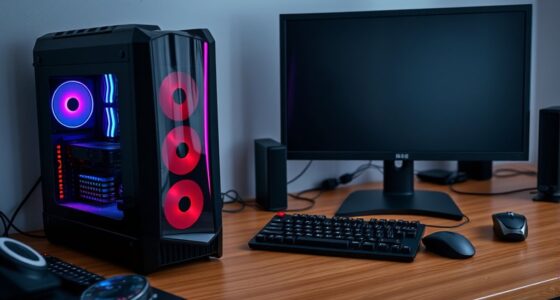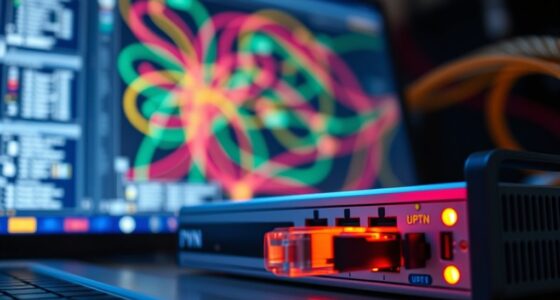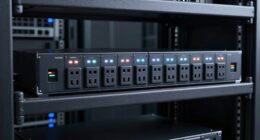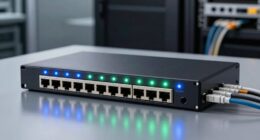If your printer won’t connect, start by checking if it’s within Wi-Fi range and free from obstructions. Restart your router and printer to refresh the connection. Verify that the printer is connected to the correct network and update its firmware and drivers if needed. Also, guarantee your computer’s system is current and security software isn’t blocking access. For more detailed steps, there’s simple ways to troubleshoot further and get your printer back online.
Key Takeaways
- Ensure the printer is within Wi-Fi range and connected to the correct network.
- Restart the router and printer to refresh network connections.
- Update printer drivers and firmware from the manufacturer’s website.
- Remove and re-add the printer via your device’s printer settings.
- Disable and re-enable the wireless adapter, and check for network congestion.

If your printer refuses to connect, it can be frustrating, but most issues have straightforward solutions. The first thing to try is wireless troubleshooting. Many connection problems stem from interference, incorrect network settings, or signal issues. Make sure your printer is within range of your Wi-Fi router and that there are no physical obstructions blocking the signal. Restart your router and printer to refresh the connection. Sometimes, a simple reboot can resolve temporary glitches. Check if your Wi-Fi network is working properly by connecting other devices; if they’re also having trouble, the issue may be with your internet service. Confirm your printer is connected to the correct Wi-Fi network by browsing its control panel or settings menu. If your printer supports WPS (Wi-Fi Protected Setup), use it to establish a quick, secure connection—press the WPS button on your router and select the WPS option on your printer.
Ensure your printer is within Wi-Fi range and connected to the correct network for a reliable connection.
Another key step in wireless troubleshooting is verifying that your printer has the latest firmware installed. Manufacturers frequently release driver updates that fix bugs, improve compatibility, and enhance performance. Visit the printer manufacturer’s website to check for driver updates specific to your model. Download and install any available updates, following the instructions carefully. Updating drivers can resolve many connectivity issues because outdated firmware may not communicate properly with your network. After updating, restart both your computer and printer to confirm the new software is properly loaded.
If your printer still won’t connect, double-check your network settings on your computer. Remove the printer from your device’s list of connected printers, then re-add it. During this process, confirm you’re selecting the correct network and entering the right password. Sometimes, incorrect security credentials can be the root cause of connection failures. Also, verify that your computer has the latest system updates installed, as outdated operating systems can interfere with device recognition and communication. Additionally, ensuring your printer has a high contrast ratio can improve visibility of status messages and connection indicators, making troubleshooting easier.
In some cases, disabling and re-enabling the wireless network adapter on your computer can help. This refreshes the network connection and can clear up conflicts. If you’re using a wireless network with multiple devices, consider temporarily disconnecting some devices to reduce network congestion. Finally, make sure your firewall or security software isn’t blocking the printer’s access to the network. Adjust settings if necessary to allow communication between your computer and printer.
Frequently Asked Questions
How Do I Update My Printer’s Firmware?
To update your printer’s firmware, start by checking the manufacturer’s website for the latest firmware update. Download the update file and follow the instructions to install it, usually via the printer’s control panel or connected computer. This firmware update can improve wireless connectivity and fix bugs. Make sure your printer stays connected to Wi-Fi during the process to ensure the update completes successfully.
Can I Connect a Printer via Bluetooth?
Yes, you can connect a printer via Bluetooth. To do this, enable Bluetooth pairing on your printer and your device, ensuring both are discoverable. Make sure your printer supports wireless connectivity through Bluetooth. Then, select your printer from the list of available devices on your computer or mobile device. Follow the on-screen prompts to complete the pairing process, and you’ll be ready to print wirelessly.
Why Is My Printer Disconnecting Randomly?
Your printer might disconnect randomly due to wireless interference or incompatible drivers. To fix this, move your printer closer to your Wi-Fi router, reducing interference. Check for driver updates and reinstall if needed, ensuring compatibility with your device. Restart your router and printer to reset connections. Avoid other electronics that might cause interference, and verify your printer’s firmware is current. These steps should stabilize your connection and prevent random disconnections.
How Do I Reset My Printer’s Network Settings?
Ever wondered how to start fresh with your printer’s wireless setup? To reset your printer’s network settings, go to the settings menu, find the network or wireless options, and select “Reset Network Settings” or a similar choice. This performs a network reset, clearing old connections. Afterward, set up your wireless connection again from scratch, ensuring your printer connects smoothly and stays reliable. Wouldn’t that make your printer work flawlessly?
What Should I Do if My Printer Is Not Detected by My Computer?
You should start troubleshooting connectivity by checking if your printer is properly connected to the network. Run network diagnostics on your computer to identify any issues. Make certain your printer is on the same Wi-Fi network and restart both devices if needed. Update your printer drivers, and if it still isn’t detected, try reconnecting the printer to your network or resetting your network settings. This often resolves detection problems quickly.
Conclusion
To fix your printer that won’t connect, you need to check your connections, restart your devices, and update your drivers. You need to verify your network settings, make sure your printer is online, and run troubleshooting tools. You need to stay patient, stay persistent, and stay proactive. By following these steps, you’ll restore your printer’s connection, restore your productivity, and restore your peace of mind. Keep troubleshooting, keep trying, and you’ll get your printer working again.









